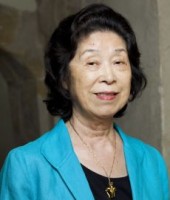Emiko Ohnuki Tierney
Emiko Ohnuki-Tierney is born and raised in Japan. After a B.A. degree from Tsuda College in Tokyo, she came to the United States on a Fulbright scholarship. Her anthropological work began with an anthropological history of the Detroit Chinese community since their arrival in the city (the only study of the "China Town," now demolished).
She then turned to the Sakhalin Ainu resettled in Hokkaido, resulting in three books. Realizing the limitation of studying a "memory culture," she shifted her focus on the Japanese, with Illness and Culture in Contemporary Japan as her first book on the Japanese. This work made her realize how one fails to understand the people and their way of life by studying only at a particular point in time. All her subsequent works have considered long periods of Japanese history to understand "culture through time." Her foci have been on various symbols of identities of the Japanese, such as rice and the monkey, within broader socio-political contexts and in comparative perspective. Her latest work began as a study of symbolism of cherry blossoms and their viewing in relation to Japanese identities. But she soon realized how the governments, since the end of the nineteenth century through World War II, manipulated cherished symbolism, such as that of cherry blossoms, and especially its folk aesthetic in order to co-opt people for their own purposes, such as waging wars and imperial expansions, without people realizing it. The work culminated in her two most recent books, with the last one, Kamikaze Diaries, introducing the diaries of student soldiers whom the government drafted and sent on the death mission known outside of Japan as "kamikaze." She continues to explore the general theories about the role of symbolism and folk aesthetic in historical and cross-cultural perspective and to show how the "culture concept" itself must be historicized, rather than thrown away altogether.
All her books have been re-written in Japanese for the Japanese readership. Her books have been translated into several languages, including Italian, Korean, Polish and Russian.
The roles of symbolism in political spaces have been my interest for some time, but most fully articulated in my last two books. Kamikazes: Fleurs de cerisier de nationalismes (2013, Hermann, avec la participation de l’Institut d’Études Avancées-Paris) led me to understand how a quotidian symbol, like a flower, and the folk aesthetic can play a role in leading people to violence and wars. In my forthcoming book, Flowers That Kill: Communicative Opacity in Political Spaces (July 2015), I compared the uses of Japanese cherry blossoms and German roses. This study convinced me of the power of a comparative perspective, which illuminates both theoretical understanding and the Japanese case with insights not readily acquired by a singular focus on the Japanese. In my current project, I follow this interest while taking up a very different historical period—late medieval Japan—as a launching pad for a larger research project on the power of symbols. The focus is on the struggles between the emperors and warlords, which centered on the symbols of prestige and honor rather than material goods or military strength. The Japanese emperors, who originated as shaman-rice farmers, never had a standing military force. During a span of barely half a century toward the end of the medieval period, warriors usurped the imperial power without revolution or bloodshed. Yet they never completely ignored the symbolic power of the emperors. Furthermore, they established their own culture underlined by their own aesthetic system, which today is considered the Japanese culture.
|
Communication d'E. Ohnuki-Tierney, résidente 2010 et 2016 de l'IEA de Paris Conférence d’E. Ohnuki-Tierney (résidente de l'IEA de Paris) |
|
American Anthropologist American Anthropologist Perspectives |
|
|



